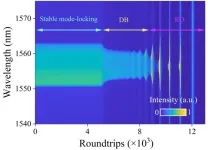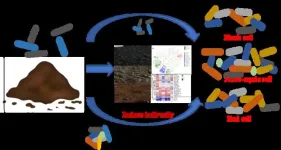(Press-News.org) COLUMBUS, Ohio – A new study has found that the brain system enabling us to inhibit our own pain changes with age, and that gender-based differences in those changes may lead females to be more sensitive to moderate pain than males as older adults.
Researchers used fMRI scans to examine brain responses in men and women who had rated the intensity and unpleasantness of pain during exposure to increasing levels of heat. The results suggested that established gender differences in pain perception could likely be traced at least in part to this brain network, and offered new evidence that those gender differences may become more disparate with age.
“The most novel part of this study is looking at gender by age,” said lead study author Michelle Failla, assistant professor in the College of Nursing at The Ohio State University. “Most of the work characterizing which regions in the brain respond to pain have been done in people aged 18 to 40. We want to understand what’s happening between the ages of 30 and 90 years old because that’s when people are beginning to experience chronic pain.”
The study was published recently in The Journal of Pain.
Plenty of previous research has shown that females are more sensitive to pain than males, but the brain regions and functions behind the gender differences in pain perception have mostly remained a mystery. And in later adulthood, when risk for chronic pain is higher and our tolerance for pain drops, even less about the brain’s role in pain perception is known.
In this study, the researchers specified that they holistically examined gender-based differences that may relate not just to biological sex, but also to social factors that influence how people respond to pain.
The imaging component of the study zeroed in on the descending pain modulatory system (DPMS), a hub of brain regions that communicate with each other to engage signal transmission – including activation of opioid receptors – that enables us to reduce our own pain.
The study sample included 27 females and 32 males between ages 30 and 86 who were asked to report when applied heat reached levels of just-noticeable, weak and moderate pain and to rate how unpleasant each level felt. Researchers used the fMRI imaging to observe DPMS activity that corresponded with each participant’s individual pain response.
“There are different brain regions involved in those distinctions between perception of pain intensity and unpleasantness, so we thought it was important to look at both and see how those brain regions are recruited during pain,” said Failla, also an investigator in the Center for Healthy Aging, Self-Management and Complex Care in Ohio State’s College of Nursing.
Results showed that a few regions within the brain’s pain modulatory system did indicate a gender-by-age difference: At the moderate pain level, men showed an increased DPMS response with older age, while as women aged, the DPMS response decreased. A decreased response in the brain is presumed to translate into a lower ability to harness our own physiological functions to reduce our pain.
Presumed is a key word: While the DPMS is believed to have a significant role in pain sensitivity and tolerance, researchers are still working toward describing exactly how it works and how an intact versus dysfunctional system shows up in scans.
“We don’t know exactly what is an optimum DPMS response,” Failla said. “Are we seeing it activated to catch up with your pain, or is it already working, meaning the pain could have been worse?”
The researchers are continuing this work, which includes investigating brain activity in people who may have a difficult time articulating the pain that they’re feeling – such as people with dementia or autism.
The more scientists can learn about the brain’s role in pain perception, the better the chances are for more effective pain management, Failla said.
“Pain is such an individual experience. In science we’re moving toward individual factors that can influence pain specifically and what makes it different for each person,” she said. “This could then identify a mechanism we can target, or even just give us a better understanding that there are different levels of innate abilities to modulate pain.”
This study was conducted at Vanderbilt University Medical Center and was supported by a National Institute on Aging grant awarded to co-authors Todd Monroe of Ohio State and Ronald Cowan of the University of Tennessee Health Science Center.
Other co-authors include Paul Beach of Emory University, Sebastian Atalla of the University of North Carolina, and Mary Dietrich and Stephen Bruehl of Vanderbilt University.
#
Contact: Michelle Failla, Failla.10@osu.edu
Written by Emily Caldwell, Caldwell.151@osu.edu; 614-292-8512
END
Photoluminescent molecules, capable of absorbing and re-emitting light, play an important role in the development of technologies such as light-emitting diodes, sensors, and displays. Among them, ordered arrangements of π-electronic molecules such as crystals of organoplatinum(II) complexes, where a platinum(II) ion is coordinated by organic ligands in a square-planar arrangement, stand out for their applications in energy-efficient flexible displays. However, their luminescence in the solid state is short-lived due to the interaction between excitons (bound electron-hole pairs) of neighboring molecules. To address this ...
A new system that brings together real-world sensing and virtual reality would make it easier for building maintenance personnel to identify and fix issues in commercial buildings that are in operation. The system was developed by computer scientists at the University of California San Diego and Carnegie Mellon University.
The system, dubbed BRICK, consists of a handheld device equipped with a suite of sensors to monitor temperature, CO2 and airflow. It is also equipped with a virtual reality environment that has access to the sensor data and metadata in a specific building while being ...
PULLMAN, Wash. – A snippet of hair can reveal a pregnant person’s stress level and may one day help warn of unexpected birth problems, a study indicates.
Washington State University researchers measured the stress hormone cortisol in hair samples of 53 women in their third trimester. Of that group, 13 women who had elevated cortisol levels later experienced unpredicted birth complications, such as an early birth or hemorrhaging.
While more research is needed with larger groups, this preliminary finding could eventually lead to a non-invasive way to identify those ...
Palliative care is the interdisciplinary medical specialty of caring for people with serious and often terminal illnesses. Its aim is to improve quality of life for such patients and their families, by relieving symptoms and stress. Palliative care is widely considered to be a human right, even if the World Health Organization estimates that only 14% of the approximately 56.8 million people who need it each year worldwide actually receive it. Since seriously ill patients often experience stress, psychological interventions such as relaxation therapy play an important role in palliative care.
Now, researchers have shown in a ground-breaking clinical trial ...
Since the onset of COVID-19, we've become accustomed to seeing antiviral films attached to elevator buttons and public transportation handles. However, conventional antiviral films are made by mixing antiviral metal particles with polymers. Due to the manufacturing process, only a very small fraction of these metal particles is exposed on the surface. As a result, contrary to the belief that these films will protect us from viruses, the actual antiviral effect upon contact with the film surface is not ...
LiDAR sensors are indispensable for the realization of advanced technologies such as advanced driver assistance systems (ADAS), autonomous driving, and AR/VR. In particular, short- and mid-range LiDAR used in AR/VR devices and smartphones requires better distance (depth) resolution to detect the shape of a person or object more accurately, and so a single-photon detector with better timing jitter performance is required.
LiDAR measures distance and creates a 3D image by calculating the time it takes for a photon emitted by the transmitter to strike an object, reflect, and arrive back at the ...
Solitons are quasiparticles that propagate along a non-dissipative wave. Put another way, they are waveforms that hold their shape as they move—like a single wave moving across the surface of a pond. They can also show the particle-like behavior, such as collision, attraction, and repulsion. Ultrafast fiber laser is an ideal platform to explore nonlinear dissipation dynamics, but also deepen the understanding of optical soliton properties. In dissipative system, dissipative soliton can be obtained due to the balance between nonlinearity and ...
DALLAS, Jan. 30, 2024 — A new survey conducted by the American Heart Association, which is marking one hundred years of service saving lives, suggests that increased visibility of the need for CPR has had a positive impact on someone’s willingness to respond if they are bystanders in a cardiac emergency. However, there remains a significant gap in awareness that emphasizes the urgent need for collaboration between governments, communities, businesses and the media to promote and provide lifesaving training. To help close this gap, the ...
In agroecosystems where manure is applied as organic fertilizer, these antibiotic residues exert strong selective pressure on soil microbial communities. Antibiotic-resistant bacteria (ARB) from animal manure would increase the concentration of ARB in soils. The influencing mechanisms of soil types on the distribution of ARB were worthy of further exploration. This study demonstrates that CTC-manure induced more resistance of soil indigenous microbes in fluvo-aquic soil, Lactobacillus, Dyella, Ralstonia, and Bacillus ...
A first of its kind study of the 2019-2020 ‘Black Summer’ bushfires in Australia has revealed that the tourism industry nationwide took an immediate hit of $2.8 billion in total output to its broader supply chains and almost 7300 jobs disappeared nationwide.
The fires four years ago triggered widespread tourism shutdowns in many parts of the country in the lead up to the peak Christmas and New Year season, resulting in $1.7 billion direct losses to the tourism industry, which triggered the larger drop in supply chain output.
“These results are an illustration of what can be expected in the future not only in Australia, but in other ...






